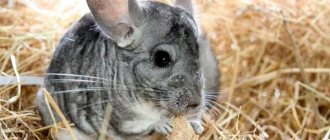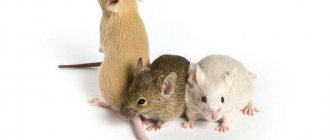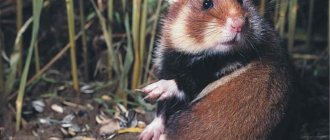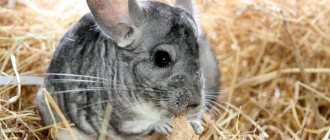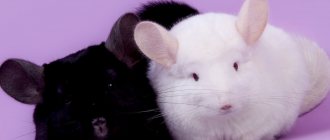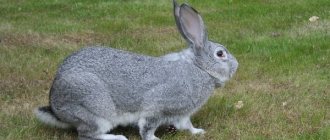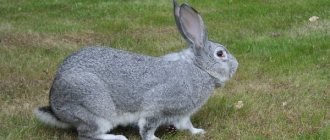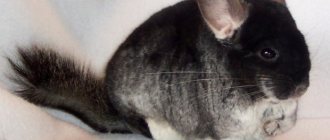08 December94122pet rodentschinchilla
The chinchilla animal is a rodent that inhabits the territory of South America. Chinchillas are known for their valuable fur, because of which their numbers have rapidly decreased and these animals are listed in the Red Book. Today the chinchilla animal is a very popular pet. Below you will find a description of the chinchilla, and you can also learn about the features of caring for and keeping a chinchilla at home.
Description of chinchilla
The chinchilla looks very cute and funny. The chinchilla animal has a large head, short neck and round body. She has large ears, a long mustache and a short tail. The chinchilla looks like a small rodent. Chinchillas range from 25 to 35 cm in length, with females being larger than males. The rodent weighs 500-700 grams.
The chinchilla looks fluffy, as if made of plush. She has soft, thick and beautiful fur. The chinchilla looks inconspicuous due to its gray-blue color and only on its belly its fur has a light gray tint. Modern colors of captive-bred chinchillas are varied and have many variations.
The description of the chinchilla includes many unusual facts about these rodents. For example, their ears have special membranes, with the help of which the animals close their ears during sand baths so that sand does not get inside. Chinchilla fur is very dense because up to 80 hairs grow from each hair follicle.
Thanks to the developed cerebellum, the chinchilla animal has good coordination and is adapted to night life. The animal's hind legs are longer than its front legs, which allows it to jump to a height of up to 2 meters. Chinchillas make many interesting sounds, they can quack, chirp, growl, squeak and click their teeth.
Where and how long do chinchillas live?
Chinchillas live for about 20 years. The homeland of these animals is South America. Under natural conditions, the chinchilla lives in the Andes of Southern Bolivia, northwestern Argentina and northern Chile. Chinchillas live in the mountains at an altitude of up to 5 km above sea level. In its natural environment, the chinchilla animal lives in rock crevices, under stones, or digs holes.
The chinchilla animal is perfectly adapted to life in the mountains. The structure of the skeleton allows the animal to crawl through even the narrowest spaces, and the developed cerebellum ensures confident movement along rocks. Chinchillas live in colonies and are active at night. In nature, chinchillas feed on various herbaceous plants (cereals, beans, mosses, lichens, shrubs, cacti, tree bark) and insects.
The chinchilla animal is mostly monogamous. Chinchillas become capable of reproduction at the age of 7-8 months. The duration of pregnancy is a little more than 3 months. Usually 2-3 babies are born. The female is capable of bearing offspring up to three times a year. Chinchilla cubs are born with open eyes, erupted teeth and covered with primary hair.
It's no secret that the chinchilla animal is a source of valuable fur. Chinchillas began to be hunted for their beautiful fur in the 19th century. To make one fur coat, it takes about a hundred skins, so chinchilla fur products are rare and expensive. In 1928, a coat made from the fur of these rodents cost half a million gold marks. In 1992, the price of a chinchilla fur coat was $22,000. Currently, the chinchilla animal is protected in South America. Now in many countries there are special farms where chinchillas are bred for their fur.
Breed classification
Chinchilla is one of the representatives of the rodent order. Chinchillas in nature are small, long-tailed and coastal. The habitat of this animal is rocky terrain.
Currently, there are about 14 chinchilla breeds and 12 interbreed species.Main color: light, dark and gray, the most popular color is dark with a light zone at the roots.
How to tame a chinchilla?
It is better to get a chinchilla when the animal is no more than 2-3 months old. At this age, the animal quickly adapts to a new environment than older individuals. If you decide to get a chinchilla, remember that this is a nocturnal animal that will be active in the evening and at night. The first time after the animal appears in the house, give it a few days of rest so that it gets used to its new home.
Taming a chinchilla is not that easy. For the most part, chinchillas do not need much attention and communication with their owner. Therefore, a chinchilla should be tamed gradually. Try giving your pet a treat, open the cage door and hand the chinchilla something tasty. The pet will definitely take the treat from your hands, if not immediately, then after a while. The main thing is not to try to forcibly pick up the animal.
To tame a chinchilla you will need patience, calmness and a caring attitude. Soon the tamed animal will be safely in your arms or sitting on your shoulder. Remember that by nature the chinchilla is a gentle, timid creature and does not like loud noises. Be careful when handling your chinchilla and do not frighten it.
Character
By nature, chinchillas are very affectionate and tame; they almost never bite. The animal can bite only in a state of severe fright. All chinchillas are different, some like to be petted and others not so much, and these character traits need to be respected. What chinchillas do not tolerate is violence. In order to achieve mutual understanding with the animal, you need to show patience and persistence, and respect the peculiarities of its character and behavior.
After purchasing a chinchilla, you need to leave it alone for about a week and let it get used to its new place. Then, unpersistently, you need to extend your hand to her with a treat. If the chinchilla wants, she will come up, take the treat and climb into your arms. If not, you need to continue taming it day after day until the animal gets used to you.
A chinchilla may become offended if you leave it alone for a long time or simply do not pay attention to it. She won't want to play with you and won't even take treats from your hands.
- How much does a raccoon cost?
- Interesting facts about cats
- The richest animals
- Cat claw attachments
- Dog
- Long-eared cats
Chinchillas are very good at manipulating their owners. They know exactly what needs to be done to get what they want: they will sit in a corner and look at you with sad eyes, or they will jump on their hind legs to get a treat or go for a walk around the room.
What to feed your chinchilla?
Chinchillas are vegetarians, so when choosing food, you should take this feature of the animal into account. The chinchilla needs to be fed with special food. Pet stores have a huge range of granulated food. This food contains essential vitamins and minerals.
In addition to food, you must feed your chinchilla hay. You can prepare it yourself; for this you need to collect clover, dandelions and herbs. But you can also buy hay at a pet store. When purchasing, pay attention to the quality of the hay; it should be dry, clean, free of unpleasant odor and mold. A special hay feeder should be placed in the cage.
The chinchilla should be fed once a day. Food and water should always be fresh. Water should be given filtered or boiled. There should always be a special stone in the cage for grinding teeth, which can be purchased at any pet store.
Pelleted dry food and hay are the best diets for chinchillas. As a top dressing, you can give your chinchilla flax seeds, corn grains, dandelion leaves, birch, willow, raspberry, apple, currant and linden branches. But under no circumstances give branches of cherry, oak and coniferous trees. You should not feed your chinchilla many fresh vegetables and fruits, as this can lead to stomach problems.
Chinchillas especially love raisins, dried apricots, dried apples, pears, cherries and rose hips. But such treats should not be given often. Also be careful with nuts and seeds, they should be given in very limited quantities and only raw; fried grains are contraindicated for the animal. You should not give your chinchilla food from your own table (bread, cookies, etc.).
Animal Reproduction
A pregnant female carries children for about 120 days, during which time she gains weight well. There can be from 1 to 6 children in a litter.
An interesting fact is that after giving birth on the same day, the female begins to demand a male for the next fertilization. It’s up to you to decide whether to add a male or not, but you need to adhere to the rule: no more than two births per year. A larger amount puts a greater burden on the female’s body.
During the first days after birth, children eat only mother's milk. But in a female, not all mammary glands work, but only the first pair, very rarely - two pairs. Stronger children push away weaker ones, and there are often fights between them. In such cases, you must either ensure that all children receive milk and control this process, or feed them with artificial formula from a bottle.
Breastfeeding can last up to two months, then the grown-up offspring completely switches to an adult diet.
Care and maintenance of chinchillas at home
Keeping a chinchilla at home is no less popular than keeping a guinea pig. First of all, to keep a chinchilla you will need a spacious cage. It is better if the cage is of a tower type. The optimal solution in this case would be a display case for a chinchilla, which will be an excellent home for the animal and will fit well into the home interior. A display case for a chinchilla will satisfy all the needs of a rodent; it has a house, stairs, floors, balconies, a running wheel and other toys. In addition, cleaning in such a display case is even easier than in a cage.
Keeping a chinchilla requires maintaining a certain temperature. The chinchilla animal does not tolerate heat well, so the cage should be placed in a cool place, without direct sunlight and drafts. The optimal temperature for keeping a chinchilla will be +20-22 °C. At temperatures of +25 °C and above, the rodent will overheat. Never place the cage near batteries.
The bottom of the cage must be lined with sawdust or special filler. The animal goes to the toilet anywhere and it is very difficult to train a chinchilla to do it in one place. The litter will have to be changed at least once a week. It is better to hang the feeder and water bowl, otherwise the chinchilla may turn them into a toilet.
Caring for a chinchilla at home includes taking care of the rodent's coat. Chinchilla fur gets dirty very quickly, so the animal needs frequent hygiene procedures. But the chinchilla bathes not in water, but in special sand. Chinchillas take sand baths with diligence and sand will fly in all directions. Therefore, it is advisable to carry out this procedure outside the cage, so as not to collect sand later. The best option in this case would be a round aquarium or any other deep, stable, round-shaped container. Place it on the floor, lay newspaper under it, pour a 5-6 cm layer of sand on the bottom and put the animal there for 20-30 minutes.
Caring for a chinchilla at home includes bathing at least 2 times a week. If your home has high humidity and temperatures close to +25 °C, bathing should be done 3 times a week. Bathing is a must for an animal if you want your chinchilla to have beautiful fur. Do not forget that swimming in water is harmful to a chinchilla and will cause health problems.
Also remember that ordinary sand (sea, river) is not suitable for swimming. After all, in the wild, the chinchilla animal bathes in volcanic dust, and not in sand. Therefore, at home it is permissible to use only special sand. In addition, in ordinary sand, an animal can become infected with fungus, parasites or skin diseases. To prevent skin diseases, antifungal drugs can be added to special sand.
In general, caring for and maintaining a chinchilla at home does not require much effort. The main condition is to protect the animal from overheating and maintain the correct diet. Try not to leave the animal unattended outside the cage. Remember that rodents love to taste everything and you will be guaranteed damaged furniture. The main danger lies in electrical wires. Also, do not forget that any hard-to-reach space in the apartment will be immediately explored by a curious animal.
The chinchilla, the maintenance and care of which is quite simple, has a number of advantages and one disadvantage. The advantages include the small cost of the animal, beautiful appearance, lack of odor and shedding, and peaceful character. But the disadvantage is the nocturnal lifestyle. If you decide to get such an animal, you will have to get used to rustling, squeaking and fussing at night.
Taming
Unfortunately, a chinchilla cannot be tamed like a cat or dog. She is very independent and prefers solitude. There are happy exceptions - some shushis happily go into the arms of their owner, adore affection and attention.
In order for Shunya to become more tame, not afraid of you and feel comfortable, start taming her from the first day at home.
For the first 2 weeks, keep all contact with the chinchilla to a minimum. Let her get comfortable, get used to new food and unusual smells. To relieve stress, offer her a leaf of dried lemon balm or mint.
After two weeks, start communicating with the Shusha. Approach the cage, open it and extend your open palms towards it. Most likely, she will become interested and will sniff and lightly nibble your fingers. She might even jump into your palm. In this case, try not to make sudden movements and do not try to pull the animal out of the cage. It's better to let him get used to it and then let him go. Celebrate your success with a treat.
Next time, go further and try to lure the bully out of the cage onto your lap or shoulders. Talk to her kindly, call her by name and, of course, use a variety of goodies.
After that, try scratching it. Favorite places for affection are behind the ear, along the neck and chest. Try not to touch the back, sides and tail, this awakens protective reflexes and a sense of fear. Some shushi don't like to be touched at all. If you hear a dissatisfied crackling sound when scratching, leave the animal alone.
Never catch or handle a chinchilla against its will. This is only permitted in cases of illness or the need for examination. She will react violently to such an invasion. She may shoot urine at you, bite you, or scratch you. If you catch it regularly, your hands will become a signal of danger, and the shusha will be afraid of you.
Chinchilla diseases
Chinchilla diseases are most often the result of improper care and poor nutrition. The most common problems are: gastrointestinal upset (usually due to low-quality or expired food, poor feeding habits or a monotonous diet), hair problems (the cause may be a lack of vitamins or skin parasites), obesity, bladder stones, conjunctivitis, periodontal disease , sunstroke or hypothermia.
If you have the slightest suspicion that your chinchilla has health problems, you should contact your veterinarian. It is extremely undesirable to delay visiting a doctor, because the sooner the problem is identified, the greater the chance of curing your pet.
Take care of your pets, take care of them and do not forget that we are responsible for those we have tamed. If you liked this article, subscribe to site updates to be the first to receive the most interesting and useful articles about animals.
Don't forget to share with your friends!
